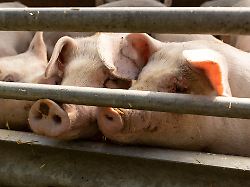Study shows disproportion
The majority of EU agricultural funding goes towards animal products
April 1, 2024, 6:57 p.m
Listen to article
This audio version was artificially generated. More info | Send feedback
Animal foods only cover a third of the EU’s calorie needs, and their production is extremely harmful to the environment. Nevertheless, according to a study, the majority of EU subsidies for agriculture go to this area. The authors call for change.
The majority of the EU’s billions in funding for farmers goes to the production of animal food. According to the most recent data available from 2013, 82 percent of the European Union’s (EU) agricultural subsidies went to this area. 38 percent of this went directly into animal husbandry and 44 percent into feed production. This is the result of a study that appeared in the journal “Nature Food” and examined food flows and their funding in more detail for the first time. Grain, vegetable or fruit production only accounts for around 18 percent of the money.
Due to the data situation, the information is over ten years old. However, little has changed in the way the money is distributed, the study authors explained when asked by “Spiegel”. In the year under investigation, 2013, the EU Commission transferred 57 billion euros to farmers; in the current funding period from 2023 to 2027, around 55 billion euros will be awarded annually.
“The results would be similar today, as the overall level of support has remained roughly the same over time and there have been only small changes in the allocation of subsidies,” explained study author Paul Behrens from the Netherlands’ Leiden University. He and his colleagues linked databases on food production and the distribution of EU agricultural subsidies. They also take into account the extent to which the food was exported to third countries or consumed within the Union.
High emissions of greenhouse gases
The numbers are not only ecologically and health-conscious, but their nutritional value is also disproportionate to the costs, according to the study authors. Meat and animal products provide just over a third of the calories needed in the EU and only around two thirds of the proteins consumed. At the same time, meat, cheese and milk are responsible for 84 percent of greenhouse gases in agriculture, while growing vegetables causes far fewer emissions.
The majority of Dutch scientists advocate restructuring EU subsidies for agriculture according to environmental and climate criteria, also because farmers themselves will ultimately be affected by the consequences of climate change. “A more plant-rich diet is urgently needed,” the paper says. This would not only reduce emissions, but also lead to greater food security and better land use.
